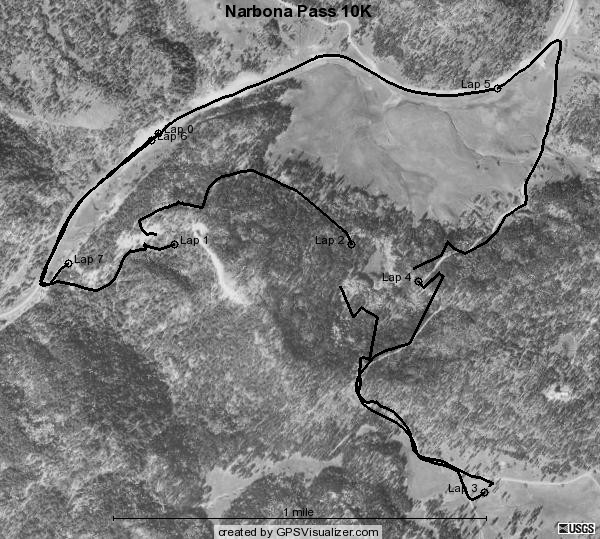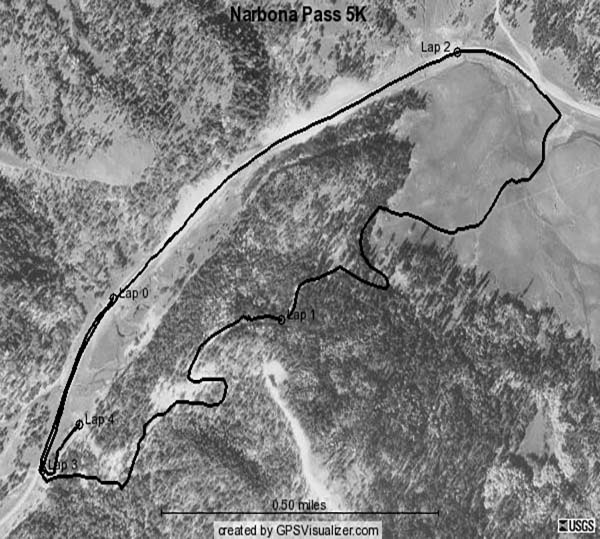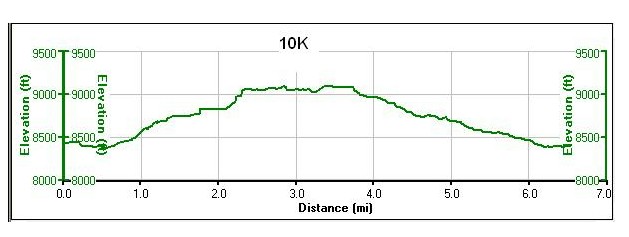Course Maps And Information
The Chuska Mountains are an elongate range on the Colorado Plateau and within the Navajo Nation. The range is about 50 by 10 miles, and it trends north-northwest and is crossed by the state line between Arizona and New Mexico near the four-corners. The highlands are a dissected plateau, with an average elevation of about 8,990 ft, and Narbona Pass is at 9,370 ft.
Narbona Pass was formerly named Washington Pass, after Colonel John M. Washington, who commanded a military expedition against the Navajo People. Narbona was a Navajo headman killed in an encounter over claims on a stolen horse with Washington’s troops in 1849. Narbona had become one of the most prominent leaders in the aftermath of the massacre of 24 Navajo leaders in June, 1822. In February 1835 he led the Navajo People in an ambush of a Mexican expedition into the Chuska Mountains led by Captain Blas de Hinojos and defeated it utterly. The site of the battle, Copper Pass (Béésh Łichííʼí Bigiizh), is now known as Narbona Pass.
The Narbona Pass Classic race started as Washington Pass Classic, when the Navajo Nation was successful in the name change, the race name changed as well. The Race registration point is at the picnic ground, about 1 mile west of the summit on Highway 134. The Carl family organized the first race in 1979 as a 4 mile run over unimproved horse trails that had been used for centuries. A total 105 runners turned out, when the norm for races were usually about 35 runners, later the race topped 740 runners and was named as one of the top 100 10K Races in the United States by Runner’s World magazine. The race was heavily contested over the narrow trail, fallen logs between the late Danny (turtle) Tsosie, Tohatchi High School and the Art Gale, Window Rock High School. Realizing the potential, a new 10K course that is known today was mapped out over the blacktop, improved gravel road, former logging road and old trails.
 Both the 10K and 5K Race start on black top (highway 134) directly east of the picnic ground with a slight downhill start. Runners run through the picnic ground and pick up the course headed directly to the first challenge. Right before the one mile point for 10K Runners, and ½ mile point for 5K Runners is ole’ Sandy. This part of the course is an uphill 200 yard stretch of loose sand making it difficult to get traction and momentum, more challenging after running faster than normal through the picnic grounds hearing spectators cheering. After topping ole’ Sandy is Backbreaker Hill, about 600 yard of steady uphill climb through forested pine. Runners are heard to comment that climb never seems to end, feels like the back is going to break, thus Backbreaker Hill. At the crest of Backbreaker Hill is the 1 mile point for the 5K race.
Both the 10K and 5K Race start on black top (highway 134) directly east of the picnic ground with a slight downhill start. Runners run through the picnic ground and pick up the course headed directly to the first challenge. Right before the one mile point for 10K Runners, and ½ mile point for 5K Runners is ole’ Sandy. This part of the course is an uphill 200 yard stretch of loose sand making it difficult to get traction and momentum, more challenging after running faster than normal through the picnic grounds hearing spectators cheering. After topping ole’ Sandy is Backbreaker Hill, about 600 yard of steady uphill climb through forested pine. Runners are heard to comment that climb never seems to end, feels like the back is going to break, thus Backbreaker Hill. At the crest of Backbreaker Hill is the 1 mile point for the 5K race.
At the crest, there is an awesome view of the Crystal valley to the west, very few take in the view for obvious reason. Shortly past the Backbreaker Hill is the turn for the 5K Race that pushes Runners downhill, down to the Narbona Pass valley, back on to black top and to the downhill finish line at the picnic ground.
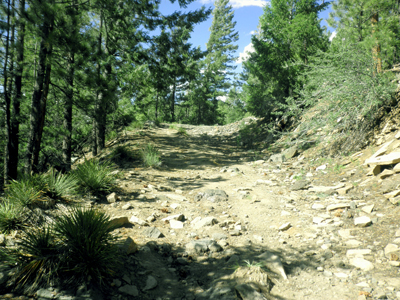 The 10K race continues through forested pines, cottonwoods with two short gradual uphill sections of the course to the 2 mile point. Right past the 2 mile point is the infamous Goat Hill; the course starts as a gradual incline and gets steeper close to the top with loose rocks and uneven footing. In the 1980s, as the elite group was racing, a flock of sheep and goats were grazing nearby. A goat decided to join the race and ran alongside Runners until half way up, could go no more, accordingly, the name, Goat Hill.
The 10K race continues through forested pines, cottonwoods with two short gradual uphill sections of the course to the 2 mile point. Right past the 2 mile point is the infamous Goat Hill; the course starts as a gradual incline and gets steeper close to the top with loose rocks and uneven footing. In the 1980s, as the elite group was racing, a flock of sheep and goats were grazing nearby. A goat decided to join the race and ran alongside Runners until half way up, could go no more, accordingly, the name, Goat Hill.
Runners cresting Goat Hill get to coast down hill for a short distance before making a circle in the valley as what is known as the “Where the Sun is At” in the Navajo language. Many cheering spectators watch the race with their set-up chairs and help with the water station at the turn around. The 3 mile point is the right before starting up a short hill that Runners had coasted earlier, this part of the course is where Runners can see who is ahead, and a steady stream of encouragements to each other are heard above the whisper of the wind through the trees.
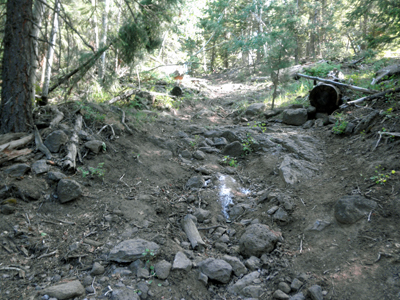 After cresting the hill, Runners are awarded with a down hill plunge back to the finish. This part of the course is an improved gravel road that is a heavily traveled road connecting families to sheep camps in the Long Lake and Whiskey Lake areas; it also serves as a route to the radar station on top of Narbona Pass. Although, the downhill is a relief for many runners, it is also a struggle for runners that have spent considerable effort on the uphill section of the race and suddenly find little get-go to enjoy the downhill. Most of the close contested races over the years have been won or lost in this section of the race. At the 4 mile point, Highway 134 is visible, once on the highway, Runners find a steady downhill section of the race, past the 5 mile point back to the finish, however, sometimes the steady head wind that tunnels through the canyon of Narbona Pass can be a challenge. At 5 ½ mile point the finish line comes into view, vehicles lining both sides, spectators lining the course, the race announcer exhorting runners to sprint for the finish, and of course, the smell of freshly cooked fry bread, often referred to as the Navajo steroid. You have made the FINISH!!!
After cresting the hill, Runners are awarded with a down hill plunge back to the finish. This part of the course is an improved gravel road that is a heavily traveled road connecting families to sheep camps in the Long Lake and Whiskey Lake areas; it also serves as a route to the radar station on top of Narbona Pass. Although, the downhill is a relief for many runners, it is also a struggle for runners that have spent considerable effort on the uphill section of the race and suddenly find little get-go to enjoy the downhill. Most of the close contested races over the years have been won or lost in this section of the race. At the 4 mile point, Highway 134 is visible, once on the highway, Runners find a steady downhill section of the race, past the 5 mile point back to the finish, however, sometimes the steady head wind that tunnels through the canyon of Narbona Pass can be a challenge. At 5 ½ mile point the finish line comes into view, vehicles lining both sides, spectators lining the course, the race announcer exhorting runners to sprint for the finish, and of course, the smell of freshly cooked fry bread, often referred to as the Navajo steroid. You have made the FINISH!!!
Narbona Pass Classic has been directed towards family and fitness. Shima Ella for years made sure that there was something for Runners to eat; many came from all parts of the world, including former Olympians and World Class runners. But more importantly, the race provide a time for many that were troubled to set aside old goals, set new goals to train for this race, sometimes defeating the demon of alcoholism and drugs by continuing to run and gain new friends. This race is also a proving ground for young Navajo runners to race against the best, getting ready for the High School Cross-Country season or sometimes getting to meet college coaches at the race and getting scholarship for college. For many, it is exciting to watch the youth participate, it is even more exciting to watch the whole family at the starting line and later cross the finish line and to see the joy is fulfilling. Narbona Pass Classic serves purpose as a family reunion every year, a great time to spend Fourth of July weekend amongst families and friends who attend. Above all is the renewal of friends, the encouragement; the opportunities for Navajo People to come home from far-away areas to be among Family.
